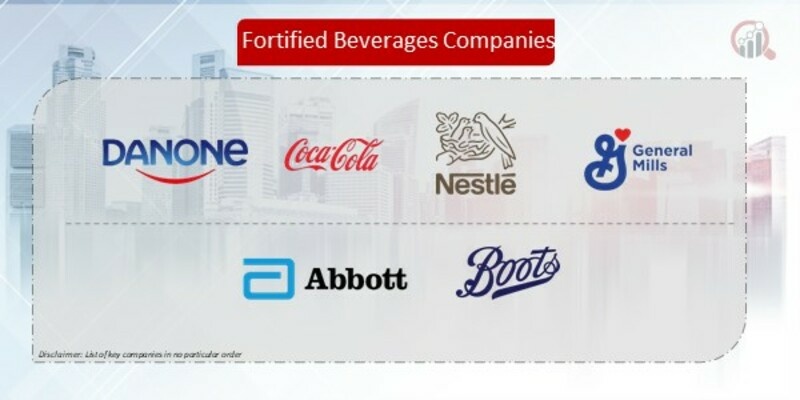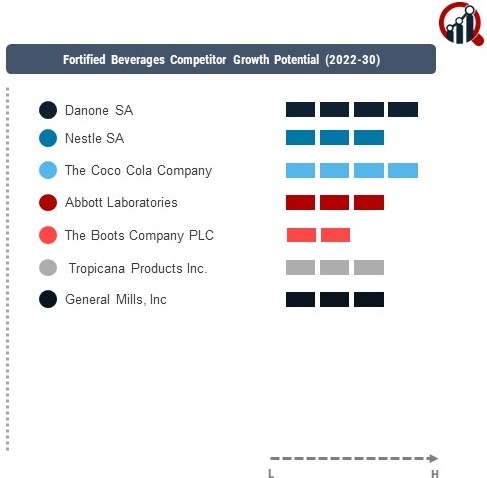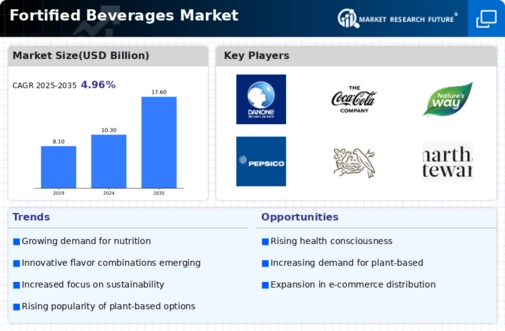Top Industry Leaders in the Fortified Beverages Market

Strategies Adopted by Fortified Beverages Key Players
The Fortified Beverages market is a dynamic sector experiencing substantial growth as consumer preferences shift towards functional and health-oriented beverages. This analysis delves into the key players, strategies, market share dynamics, emerging companies, industry trends, current investments, the overall competitive scenario, and a notable development in 2023.
Key Players:
Danone SA (France)
Nestle SA (Switzerland)
The Coco-Cola Company (U.S.)
The Boots Company PLC (U.K.)
Tropicana Products Inc. (U.S.)
General Mills, Inc. (U.S)
Abbott Laboratories (U.S.)
Strategies adopted by key players in the Fortified Beverages market center around innovation, diversification, and strategic partnerships. Recognizing the increasing demand for beverages with added nutritional value, companies invest significantly in research and development to create innovative products that address specific health and wellness concerns.
Diversification is a key strategy, with companies expanding their portfolios to include a wide range of fortified beverages catering to different consumer needs. This diversification ensures that key players capture a broader market share by offering options such as vitamin-enhanced waters, functional teas, and protein-infused beverages.
Strategic partnerships and collaborations are integral to expanding market reach. Fortified beverage manufacturers often engage in partnerships with health and wellness organizations, fitness influencers, and retail chains to enhance brand visibility and reach a wider consumer base. Such partnerships contribute to the overall success and market penetration of fortified beverage products.
Market Share Analysis:
Several factors contribute to market share dynamics in the Fortified Beverages market. Brand recognition and loyalty are paramount, with consumers gravitating towards established brands with a positive reputation for quality and innovation. Key players that consistently deliver on consumer expectations build a loyal customer base, contributing to sustained market share.
Innovation in formulation and packaging plays a crucial role. Companies that pioneer new ingredients, manufacturing processes, and packaging technologies often gain a competitive edge. Fortified beverage manufacturers that prioritize clean labels, sustainable sourcing, and environmentally friendly packaging resonate well with health-conscious consumers, influencing market share growth.
Distribution channels are critical for market share expansion. Companies with well-established and efficient distribution networks can ensure that their fortified beverages are readily available to consumers across various regions. Strategic partnerships with supermarkets, convenience stores, and online retailers contribute to broader market coverage.
News & Emerging Companies:
The Fortified Beverages market witnesses frequent news regarding product launches, partnerships, and expansions. Emerging companies in this sector often focus on niche markets or introduce innovative ingredients to differentiate themselves. These players leverage unique formulations, such as plant-based fortifications and adaptogenic infusions, to capture the attention of health-conscious consumers.
Industry news also revolves around advancements in fortification technologies, with emerging companies incorporating novel ingredients such as superfoods, probiotics, and botanical extracts. These ingredients not only add nutritional value but also align with the growing consumer demand for natural and functional beverage options.
Industry Trends:
The Fortified Beverages market reflect a commitment to sustainability, innovation, and market expansion. Research and development investments concentrate on discovering new functional ingredients and fortification methods that resonate with evolving consumer preferences.
Sustainability efforts encompass eco-friendly packaging solutions, responsible sourcing of ingredients, and reduced carbon footprints in the production process. Investments in sustainable practices contribute to positive brand image and resonate with environmentally conscious consumers.
Market expansion remains a key trend, with companies exploring opportunities in both domestic and international markets. Mergers and acquisitions are common strategic moves for companies looking to expand their product portfolios, gain access to new markets, or acquire innovative technologies. Such investments aim to strengthen the overall market position of key players.
Investments in marketing and consumer education are imperative for creating awareness about the benefits of fortified beverages. Digital marketing campaigns, collaborations with fitness influencers, and interactive consumer education programs contribute to building brand loyalty and attracting a broader consumer base.
Competitive Scenario:
The Fortified Beverages market presents a competitive landscape where established players leverage their global presence and innovation capabilities. However, the entry of emerging companies offering unique formulations and targeting specific health and wellness niches contributes to a dynamic and evolving competitive scenario.
Companies must navigate a landscape where consumer education and transparency are essential. Clearly communicating the benefits, ingredients, and nutritional value of fortified beverages is crucial for maintaining a competitive edge. The industry's adaptability to changing consumer preferences, technological advancements, and sustainability trends underscores its resilience.
Recent Development
The Fortified Beverages market was the increased emphasis on personalized nutrition. Key players introduced fortified beverage lines that allow consumers to customize the nutritional content based on their specific health goals and preferences. This development aligns with the growing trend of individualized health and wellness, indicating a positive shift towards more tailored and consumer-centric fortified beverage options.











